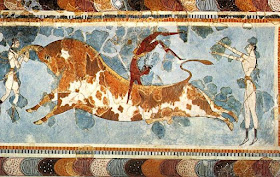Bull leaping fresco, from the Great Goddess Sanctuary in the Labyrinth, Crete, showing the members of a bull leaping team at work.
Minoan Crete had a very odd relationship with bulls and the frescos that they decorated their temples and palaces with, depicted a very peculiar ritual: that of “bull-leaping”.
This ritual involved a bull and some young acrobats (initiates?). They would run up to the bull, grasp its horns and use them to catapult themselves over the animal’s back, landing on the ground behind it.
Did it represent some kind of “regeneration”? Flying over the raging bull symbolized something (perhaps courage or bravery... what does the matador symbolize in Spanish culture? The macho he-man? Or was it merely a spectacle for the masses?
But it was not a cult (or sport?) restricted to Crete. Bull leapers are depicted in nearby Siria and even, along the shores of the Persian Gulf, in Arabia, and have been dated to 1,700 BC long before the oldest Cretan representations. [4] Perhaps this cult was an ancient religion that spanned the Middle East
Bulls and horns in Religion
Alexander Hislop, in his “The Two Babylons” [1] provides some interesting facts on bulls in the ancient Middle East and Eastern Mediterranean basin:
- Bull stands for ruler. The Chaldean word for it is Tur, which latinized becomes Taurus, and deformes into Turannus (i.e. Tyrant, but which originally meant ruler not despot!). [1]
I have always loved astronomy and recall that the precession of the equinoxes had the sun rise in the constellation of Taurus between 4320 and 2160 BC.
Precession of the Equinoxes: The Earth wobbles like a gyroscope slowing down, as it rotates around the sun. Thus the Earth’s axis moves in a circular motion taking it nearly 26,000 years to complete one rotation. This causes the constellations to rotate (very very slowly) around the Earth and take turns in occupying the position where the sun rises.
Therefore the Bull shaped constellation being the one where the sun rose, must have given it some sort of preeminence, during that period some six to four thousand years ago.
- The Greek Titan, Kronos, father of Greek Gods (the Roman Saturn), was known as “the Horned One” and horns symbolized the power of kings, and therefore royal power was represented with a crown: two horns mounted on a band. Some added even more horns and thus the spiky appearance of crowns.[1]
Dionysius horned god
Dionysius was a God the predated the Indoeuropean invasion of Greece, he was the “God of Nysa or Nyasi”. [2]
He was revered in Greece as a god of annual renewal. He was a “bull god” “bull-horned”, and as such a symbol of virility, fecundity and therefore women favoured him (the Romans took him as Bacchus, and their Bacchanalia were orgies).
The female worshipers at Laphystios “wore hons themselves[2]. Euripides Bacchae mentions him as a “horned God”.[2]
Zeus, son of Khronos, fathered a son with Persephone (his daughter – issue of Demeter –his sister), Dionysius. During the war between gods and Titans he adopted the form of a bull, he was captured and torn apart. Athene saved his heart which Zeus swallowed and from it gave birth to a renewed Dionysius.
The Titans were blasted apart by Zeus’ lighting bolts and their ashes mixed with Dionysius’ blood were the origin of humans, who carry both Titanic evil and Dionysian goodness in our souls. [3]
Comments
The Middle East and Eastern tip of the Mediterranean Sea were the source of a cult based on bulls. Horns were donned as caps during their worship. Gods bore horns on their heads, gods related to virility, sex, fecundity and renewal.
Horned god blended with horned Titan gave birth to mankind. A similar mix to what we find among Patagonian natives: ceremonies involving bulls (in a part of the world that lacked them!), rituals related to fecundity and the onset of puberty. Horned gods (by the way, Elal, the Patagonian Zeus myth is very similar to that of the Greek Titans, war and murder included).
As usual we have options, and each can make up his or her own mind on the matter:
a) Coincidence. We humans have a limited repertoire of mystic stories and many cultures assemble the same tales time and time again based on the same basic themes (lust, hate, violence, rape, war, incest, good vs. evil, etc. ).
b) Minoan, Mycenic, Greek, Phoenician or some other group of ancient mariners sailed forth from the Mediterranean, reached Patagonia and left their imprint in the form of ancient bull myths.
Minoan bull effigy. Notice the golden horns, which appear in northern Patagonian myths regarding bulls! See my posts on “Lake Bulls”
Sources
[1] Alexander Hislop, (1853). The Two Babylons or The Papal Worship Proved to be the Worship of Nimrod and His Wife. Chapter II.
[2] Marija Alseikaitė Gimbutas, (1974). The Gods and Goddesses of Old Europe: 7000 to 3500 BC Myths, Legends and Cult Images. University of California Press, pp. 227.
[3] J. R. Watmough, (1934). Orphism, Cambridge University Press.
[4] Michael Rice, (1998). The Power of the Bull Routledge.
Patagonian Monsters - Cryptozoology, Myths & legends in Patagonia Copyright 2009-2011 by Austin Whittall ©


No comments:
Post a Comment